Furniture under the sink in the bathroom: choose and
The bathroom is a place where special requirements are imposed on convenience, it can be said, the altar of the comfort of your apartment. That is why every detail of its setting should be as thorough as possible and chosen taking into account all the characteristics of the room.
We will tell you what should be a stand under the sink in the bathroom, how to choose and build your own hands the right option.
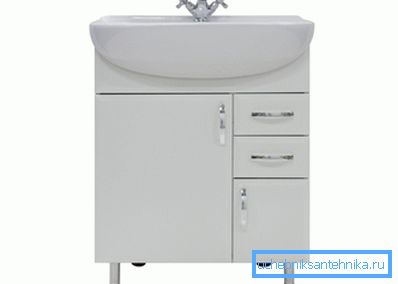
Features of operation of bathroom furniture

The first thing that needs to be learned is a number of features characteristic of bathrooms. These features are important, if not decisive, for the normal use of furniture in the bathroom, and for the proper selection of accessories they must be understood and taken into account.
The most striking difference characteristic of this part of the apartment is the particular climate. And this is not only a matter of high humidity: significant temperature fluctuations and fairly mobile air flows form a very changeable microclimate, with the result that during the day we can observe a whole complex of atmospheric phenomena, such as condensation or thick fog.
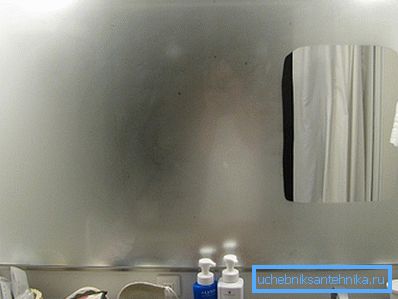
You also need to understand that a dry bathroom is an advertising myth. In practice, it is almost impossible to avoid water from falling on the floor and walls, as well as on the surface of furniture, and it is better to take into account that permanent contact with water is inevitable.
However, this is not all. As a rule, a diffuser for exhaust ventilation is located in the bathroom, which leads to constant air movement in this room.
This is necessary for the timely removal of excess moisture, but the result of this movement is a sharp change in humidity, which is especially dangerous for wood, which, depending on humidity, changes its volume and geometry.
We all know that moisture is a favorable environment for the development of life. However, unfortunately, those forms of life that have chosen the sanitary zone are not similar to raccoon seals, but are aggressive types of mold, bacteria and other microorganisms that harm not only building materials, but also furniture, and even man.

Note! Understanding the listed properties of the room allows us to determine the basic and universal requirements with which the cabinet under the bathroom sink should correspond.
To make it easier to analyze the possible choices, we will write out the basic requirements in the form of a list:
- Moisture resistance. This is perhaps the most important requirement, since in the room with the constant presence of hot steam and abundant condensate materials unfriendly to water will not last long. In addition, it is necessary to take into account the inevitable direct contact with water as a result of splashes, flooding and other similar phenomena;
- Corrosion resistance. Considering all the listed climatic features, the bathroom can be called the zone with the highest risk of occurrence of various types of corrosion - electrochemical, biological and others;
- Resistance to temperature changes. In other words, the furniture should consist of materials with a low coefficient of temperature expansion, otherwise the linear variations in the dimensions of its parts will lead to accelerated wear and problems associated with the operation of moving parts - doors, drawers, etc .;
- The possibility of simple care for the condition of surfaces. Moisture evaporation will lead to the appearance of plaque as a result of salt precipitation. Permanent procedures for their removal should not affect the appearance of products;
- Resistance to household chemicals and detergents. Caring for furniture in the bathroom involves the frequent use of detergents, in addition, on its surface will get such substances as soap, colognes, creams and other hygienic chemicals.
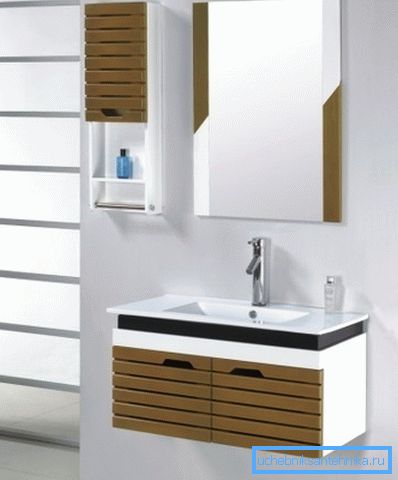
Note! You also need to understand that in most cases the size of the bathroom is limited, so another important criterion for choosing furniture for it is ergonomics and thoughtful design.
Features and types of models
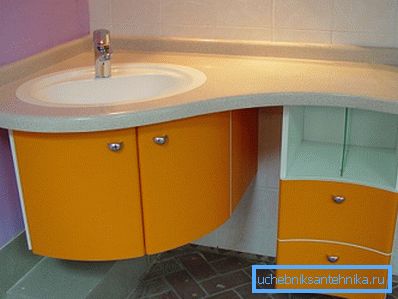
One of the defining features that characterize the quality, durability and cost of products for sanitary facilities is the material from which they are made. The requirements outlined in the previous section relate primarily to materials and their coatings.
Today, for the production of most budget furniture, including for bathrooms, use MDF and chipboard. At the same time, manufacturers claim and even guarantee its water resistance and durability; however, they cannot and do not assert anything else.
In practice, most products made of these materials come into disrepair after a year (the plywood box under the sink in the bathroom can spread out after a couple of months), rare successful exceptions live 4 to 5 years.
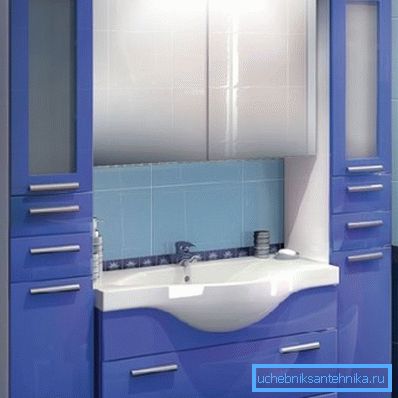
Note! If you want to put in plywood shower furniture, purchase products from well-known European companies, while checking authenticity and beware of imitations. In addition, preference should be given to models with laminate or other waterproof coating.
For lovers of the classics, there is only one way out - to establish a cabinet from the wood massif, and the choice of breed should be taken responsibly: teak, larch, wenge and oak are most acceptable.
With proper processing and good varnishing, such products can last for decades and even centuries. The price of such furniture, of course, is very high.
Stone furniture is also excellent. It is durable, easy to clean, does not emit harmful substances when heated. The high cost of natural stone - a natural phenomenon, but you can stop the choice on cheaper artificial materials.
The most acceptable option would be a shelf in the bathroom under the sink or cabinet, made of stainless steel, silicate or organic glass, plastic.
Fittings should be chrome plated or made of stainless alloys. Such products are usually affordable and meet the requirements listed by us.
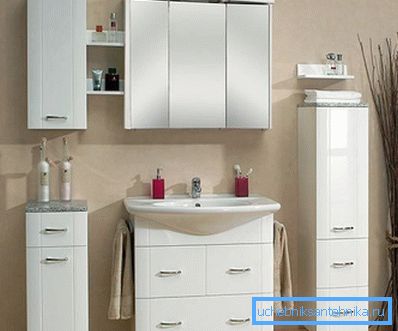
Now consider the types of thumbs.
They are of several types:
- Suspended and console;
- On the legs;
- Socle.
Hanging pedestals and shelves-consoles
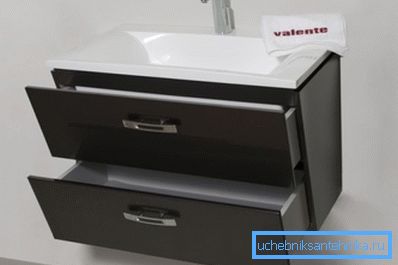
Suspended and console models allow you to visually unload space. For small rooms, they are the most suitable, under them easy to clean the floor and clean.
The only restriction is the need for capital stone walls, since it is impossible to hang such pedestals on hollow and plasterboard structures. (See also the article The Corner Shell: Features.)

Also popular today, console shelves, countertops, which are embedded in the sink. They take a minimum of space, while increasing comfort and convenience due to the surface, similar to the table for cosmetics.
Nightstands with legs

If you like a classic - then we advise you to pay attention to the bedside tables with legs. They will fit well into the traditional interior, besides, these products are not as bulky as the socle analogues.
Like console models, tabletops with legs do not cover the floor and allow cleaning. You can hide small items under them - floor cloths, various chemicals, etc.
Note! The main advantage of these models is the lack of body contact with the floor. As a result, when the flood or the formation of puddles your furniture will not suffer.
Base models
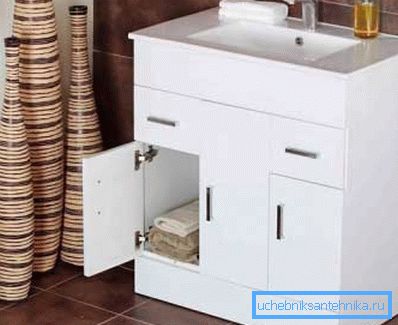
No less common basement tables. They differ from the previous class in the absence of legs, instead of which the product rests on the floor with the whole body. At the bottom there is a basement compartment, formed by a raised bottom.
Such furniture is simpler and more stable, however, when flooding the floor or forming a puddle, water will affect the material of the case, which is not very good, since the capillary suction of moisture in the case of wooden execution will deliver water to higher parts.
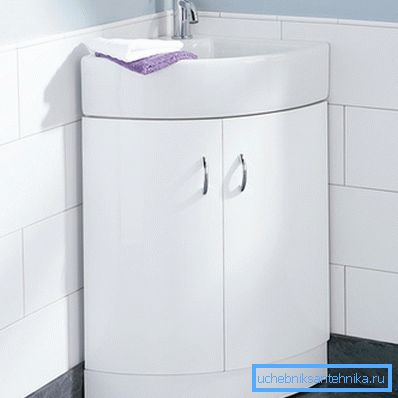
Note! Wooden products with a basement case are most vulnerable, so they should not be chosen.
Assembling the bedside table under the sink
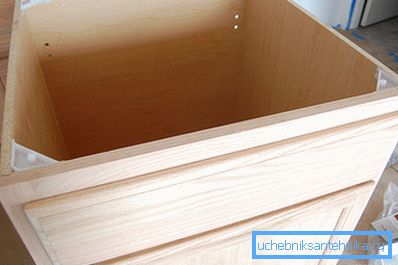
As a guide for self-installation, we offer you an example of assembling a wooden pedestal:
- We remove the dimensions of the sink and, in accordance with them, we assemble two frames from planks, which we connect to each other with two sides of a massive plank;
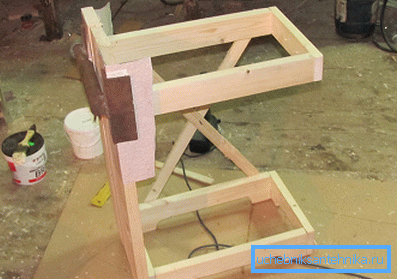
- Cut 8 corners of the board, which will strengthen the design;
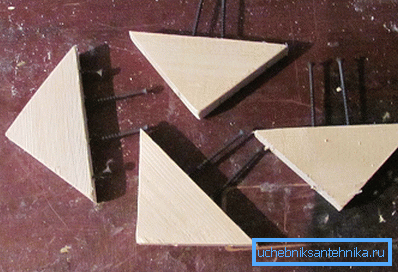
- Fasten the corners to the top and back of the frame;
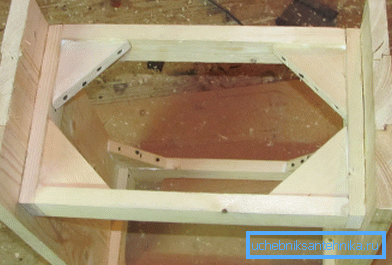
- Above the top frame with corners set decorative trim;
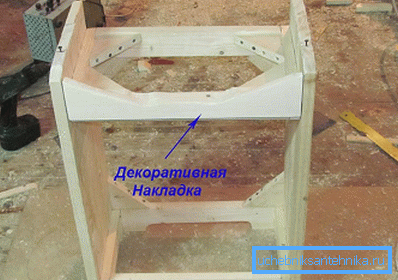
- We try on the sink and adjust the seat to its shape with the jigsaw and sandpaper;
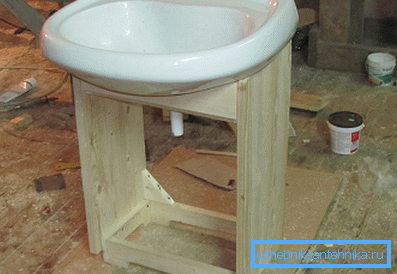
- Cut out the doors in which we make holes for mounting hinges;
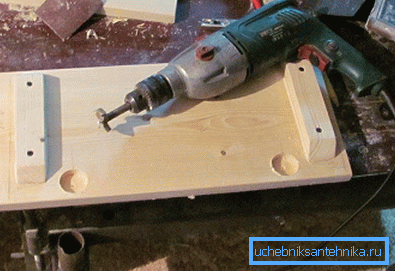
- Install the doors;
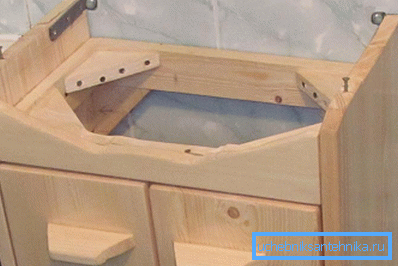
- Fasten the nightstand to the wall with brackets;
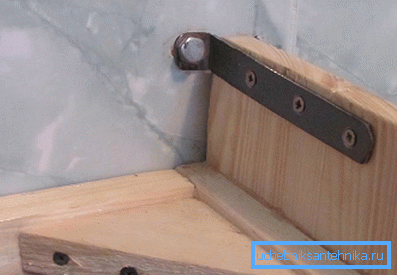
- Install the sink.
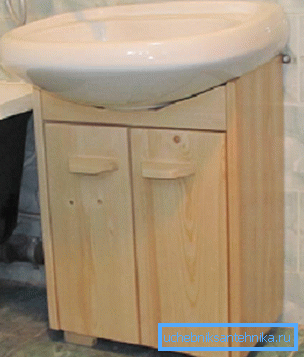
Conclusion
Bathroom furniture is distinguished by special requirements dictated by the aggressive microclimate of the bathroom. When choosing it is important to consider the material of manufacture, as well as the method of installation and the functionality of the product. The video in this article illustrates our story well.